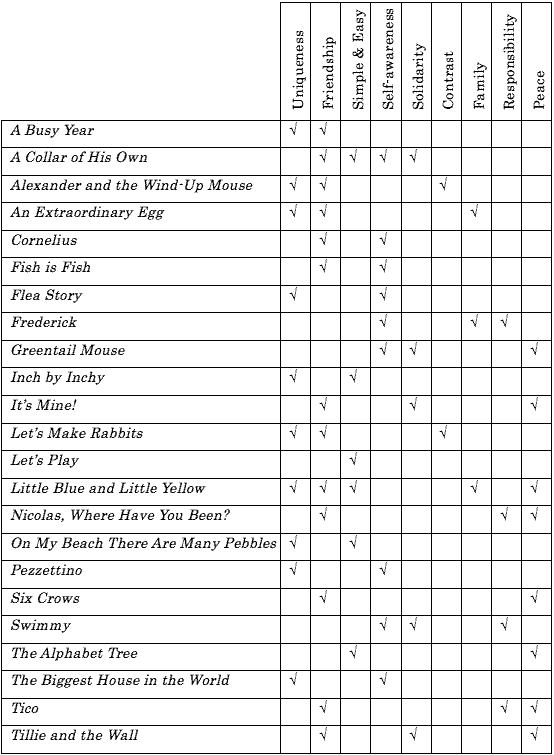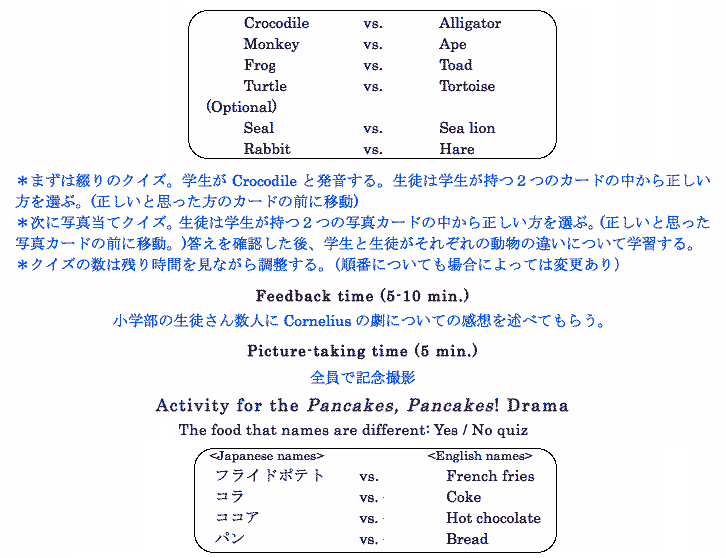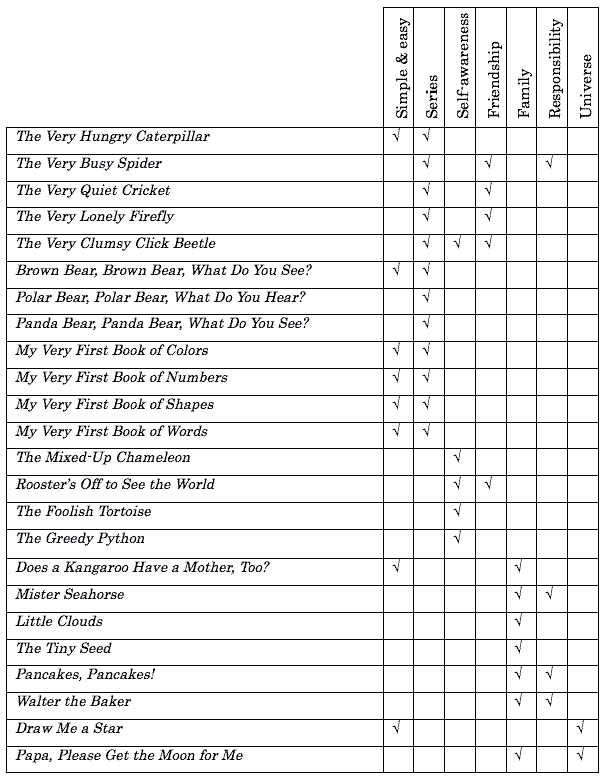
Expanding opportunities through English dramaby Miori Shimada (Tamagawa University) |
| "The drama activities described herein enabled the university students to gain some confidence to speak English in front of people. That is an essential quality for a teacher." |
[ p. 54 ]
By working together, the students learn to feel their way to creating their own parts and adapting them as they come up against others. The problem of not wanting to speak or, more often, not knowing what to say is practically resolved because the activity makes it necessary to talk. (p. 9).
| # of Students | M / F | Majors | Academic Years | |
| 2007 Class | 5 | 2 / 3 | Education | 2, 3, 4, & Grad. |
| 2008 Class | 4 | 4 / 0 | Education | 2 & 3 |
| Class time | # of classes | Time span | Extra lessons (for meeting/rehearsal) |
|
| 2007 Class | 13:00 - 14:40 | 15 | Sep. '06 - Jan. '07 | *1 |
| 2008 Class | 13:00 - 14:40 | 15 | Sep. '07 - Jan. '08 | *2 |
[ p. 55 ]
* Extra lesson for rehearsal a few days before the actual performanceProcedure
** All three sophomore students took turns visiting the elementary school during their free class time periods on separate weekdays to discuss about their performance and the script with the native-speaker teacher there.
| Lesson | 2007 | 2008 |
| 1 | ◌ Course syllabus and timetable |
◌ Course syllabus and timetable |
| 2 | ◌ "Simple and Easy" books |
◌ The "Very" book series |
| 3 | ◌ Books with "Interesting contrasts" |
◌ "Simple and easy" books |
| 4 | ◌ "Unique" books |
◌ Books about "Self-Awareness" |
| 5 | ◌ Books about "Friendship" |
◌ Books about "Family" |
| 6 | ◌ Books about "Family" |
◌ Books about "Family" |
| 7 | ◌ Books about "Self-Awareness" |
◌ Select books from "Universe" |
| 8 | ◌ Books about "Self-Awareness" |
◌ Guest Speaker's DayStudent scripts due |
| 9 | ◌ Books about "Responsibility" |
◌ Review feedback from First Division |
| 10 | ◌ Student scripts due |
◌ Class observations |
| 11 | ◌ Books about "Peace" |
◌ Make changes and script additions |
| 12 | ◌ Class Observations |
◌ More script-development, |
| 13 | ◌ Practice |
◌ Practice |
| Extra lesson | ◌ Rehearsal |
◌ Final revision of the script |
| 14 | ◌ Performance |
◌ Rehearsal |
| Extra lesson | ◌ Final check and inclusion of |
|
| 15 | ◌ Feedback and the wrap-up lesson |
◌ Performance |
[ p. 57 ]
[ p. 58 ]
Audience Feedback| Rank | Comment | #Stds. making this comment |
1 |
◌ The play was very interesting. |
10 |
2 |
◌ The university students performed quite well. |
8 |
3 |
◌ We want to see the play again. |
7 |
4 |
◌ The actors' voices were clear and their pronunciation was good. |
4 |
5 |
◌ The drama was warm-hearted. |
3 |
5 |
◌ We want to perform in English like these university students. |
3 |
5 |
◌ I understood around half of the drama since it was in English. |
3 |
| Rank | Comment | #Stds. making this comment |
1 |
◌ It was a fun game. |
5 |
2 |
◌ It was a bit difficult to answer. |
3 |
3 |
◌ It was easy to answer. |
1 |
3 |
◌ I was happy to get all the answers correct. |
1 |
3 |
◌ For me, this game was a unique experience. |
1 |
3 |
◌ I want to play this game again at home. |
1 |
| "The drama activities described in this paper appeared to promote cooperation, enhance individual talent, and raise the levels of respect among the classmates when each student became responsible for his/her role as a leader, coordinator, prop designer, music creator, and so on." |
[ p. 59 ]
[ p. 60 ]

[ p. 61 ]
| Category ("series" or "theme" based) | |
|---|---|
| Title | Recommendation when using a "Big Book" |
|
1. Main character 2. Other special character(s) 3.Teachable words/subjects |
Activities * 0ther products (puzzles, videos, etc.) of the same title, available from toy stores, websites, or in the references. |
| Friendship/Self-Awareness | |
|---|---|
| Cornelius | |
|
1. Cornelius 2. Monkey, other crocodiles 3. Some differences between crocodiles and alligators: walk/stand upright, stand on their heads, hang from their tails, adjectives to express emotion, body parts of animals 4. "So what?", "Can you do it?", "I can do it" 5. Collage |
◌ Copy the action each student acts out ◌ Teacher gives commands: up, down, right, left, forward, backward ◌ Presentation (by saying "I can do a handstand", etc.) ◌ Guessing names of things which are placed upside down ◌ Interview game (by asking "Can you do this?") ◌ Quiz show (by asking "Who can do this?") ◌ Making a book about each student who has a special talent ◌ From Head to Toe (Eric Carle), The Rainbow Fish (Marcus Pfister), Swimmy (Leo Lionni), The Ugly Duckling (H. C. Andersen) |
[ p. 62 ]
| NOTE: For a version of this with some Japanese gloss, refer to the PDF edition of this article. |
| [Scene 1] | |
| MC: | Hi. How are you? The name of this play is Cornelius. Do you know what Cornelius is? Cornelius is a crocodile. What's a crocodile? |
| [Scene 2] | |
| MC: | Good! This is a crocodile. Let's start the story. Now close your eyes. You are in the jungle. There are many tall trees. Birds are singing. The sun is bright. It's hot! |
| (Crocodile 1 and Crocodile 2 enter the stage) | |
| MC: | Oh, crocodiles! Good morning! |
| Cr1&2: | Good morning. |
| MC: | Are you Cornelius? |
| Cr1: | No. |
| MC: | Are you Cornelius? |
| Cr1: | No. Cornelius is over there. |
| MC: | Oh, What a surprise! You stand upright. |
| Corn: | Yes. I can walk upright! |
| Cr1: | So what? |
| Corn: | I can do some other tricks. |
| MC: | Is that right? Can you show us? |
| Corn: | OK! |
| Cr2: | So what? |
| Cr1&2: | So what? |
| Cr1: | So what? |
[ p. 63 ]
| [Scene 3] | |
| Monkey: | Hi. |
| Corn: | Hi. |
| Monkey: | What's wrong? You look very sad. |
| Corn: | Yeah, nobody cares about my tricks. . . How about you? Do you want to see my tricks? |
| Monkey: | Of course. |
| (Cornelius performs a trick) | |
| Monkey: | Great! |
| Corn: | Thank you! |
| Monkey: | So, can you do this? |
| Corn: | Wow, I'm surprised. Fantastic! Great! Can you show me how to do them? |
| Monkey: | Of course! I'll show you! Now, everyone, stand up! We'll do them together. OK! Everyone is great! Now, sit down please. |
| Corn: | Thank you. I'm very happy. |
| Monkey: | You are welcome. I'm happy, too. |
| Corn: | Bye! |
| Monkey: | Bye! |
| [Scene 4] | |
| Corn: | I'm home. Look! I have a new trick. |
| Cr1&2: | So what? |
| SONG: | Can you do this difficult trick, difficult trick, difficult trick?
Can you do this difficult trick? Yes, we can. No, we can't. |
[ p. 64 ]

Can you do this difficult trick, difficult trick, difficult trick? Can you do this difficult trick? Yes, I can. / No, I can't. (Yes, we can. / No, we can)
[ p. 65 ]

[ p. 66 ]
| Category ("series" or "theme" based) | |
|---|---|
| Title | Recommendation when using a "Big Book" |
|
1. Main character 2. Other special character(s) 3.Teachable words/subjects |
Activities *---0ther relevant book titles |
| Family/Responsibility | |
|---|---|
| Pancakes, Pancakes! | |
|
1. Jack 2. Mother, miller, animals 3. Ingredients of pancakes, kitchen utensils, recipe instruction, recipes of other foods, words describing "taste" 4. World pancakes, nutritional phrases: "We need to (verb)." "We need (noun)." How to get each ingredient 5. Recipe |
◌ Cook pancakes according to recipes ◌ Talk about typical breakfasts (lunches, dinners) around the world ◌ Create recipes of typical/new foods ◌ Create original stories based on the foods above ◌ Pancakes for Breakfast (Tomie dePaola), The Popcorn Book (Tomie dePaola) |
| NOTE: For a version of this with some Japanese gloss, refer to the PDF edition of this article. |
| [Scene 1] | |
| (Jack comes on stage) | |
| Mother: | Wake up, Jack! |
| Jack: | Ha. . . Good morning. Mom – I'm very hungry. So I will go and look for some food. |
| (Action stops and the MC enters the stage) | |
| MC: | Hi, how are you? I will be your guide for today's story. What does Jack want to eat? What do you think? |
| (Children say various foods) | |
| MC: | O.K. O.K. Please enjoy! Watch and listen for the first hint. |
| (Drama resumes) | |
| Jack: | Here is some flour. We need three more things. Let's go to the chicken farm. |
| (Sound effects as Jack goes to the chicken farm) | |
| Jack: | Oh, there is a black hen. |
| Black Hen: | Ba ba ba ba ba . . . |
| (Jack tries to catch a black hen, but it is difficult) | |
| Jack: | Mrs. Hen, Please don't run away. I just want your egg. |
| (The black hen lays an egg) | |
| Jack: | Thanks, Mrs. Hen! |
| (Action stops as the MC returns on stage.) | |
[ p. 67 ]
| MC: | Jack has some flour and an egg. What is Jack going to make? Watch and listen for the next hint. |
| (Drama resumes) | |
| Jack: | Let's go visit the cows. |
| (Sound effects as Jack goes to the ranch) | |
| Cow: | Mooooo! |
| Jack: | Mrs. Cow, don't kick me. I just want your milk. Please give me your milk. |
| (Jack milks Mrs. Cow) | |
| Jack: | Thanks, Mrs. Cow! |
| (Action stops as the MC returns on stage.) | |
| MC: | Jack has some flour and an egg and milk. What is Jack going to make? Here comes the final hint. Are you ready? |
| (Drama resumes) | |
| Jack: | Let's go home. |
| (Sound effects as Jack returns home.) | |
| Mother: | Welcome back, Jack. What do you want now? |
| Jack: | I want some butter. |
| Mother: | Sorry. We don't have any butter. So, let's make some butter, Jack. |
| Jack: | O.K. |
| (In fact, making butter) | |
| Jack: | O.K. It's finished. Now we will show you . . . |
| (Show the print and explain the appliance, then action pauses as the MC returns to stage) | |
| MC: | Jack has some flour and an egg and milk and butter. What is Jack going to make? The correct answer is . . . ? |
| (Pancakes are taken out of an oven, then Jack returns to stage) | |
| Jack: | The correct answer is pancakes. Pancakes are very delicious. Everyone, let's eat. |
| MC: | Jack, when you made the pancakes, what was difficult for you? |
| Jack: | It was difficult to get some flour and an eggs and milk and butter by myself. |
| MC: | I see. |
| Jack: | These days, it is very easy to get food. However it takes many people to get many foods. |
| (Some talk) | |
| Jack: | Therefore, you should always think about all of the people who bring food to your kitchen table. |
| MC: | Thanks, Jack! That's the end of our story. We hope you have some new ideas about the food you eat everyday. Now, let's sing the "pancakes" song together! |
[ p. 68 ]
Are you hungry? Pan, pan, pancakes Are you hungry? Pan, pan, pancakes How about you? Nice and hot How about you? Nice and hot Have some pancakes Add a little butter Have some pancakes Add a little butter Now I'm full Now it's done! Now I'm full Now it's done!
[ p. 69 ]